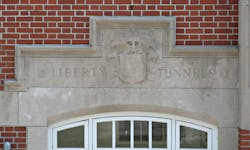Pittsburgh’s Liberty Tunnels Ventilation System Named a Historic Landmark
Pittsburgh’s Liberty Tunnels Ventilation System is now an American Society of Civil Engineers (ASCE) National Historic Civil Engineering Landmark, a little over 100 years after construction.
"The ASCE Pittsburgh Section pursued the historic landmark designation as a way to recognize the 100-year anniversary of the Liberty Tunnels and their importance to the Pittsburgh region,” said Taylor DaCanal, president of the ASCE Pittsburgh Section. “The ventilation system for the Liberty Tunnels was the first such system for an automobile tunnel in the U.S. and influenced the designs of the Holland Tunnel in New York, the Sumner Tunnel in Boston, and others."
The Liberty Tunnels — two parallel, separate tunnels with four total lanes beneath Mount Washington — opened to vehicle traffic in 1924. Over a mile long, they were the longest auto tunnels at the time.
The design engineers took particular care researching and developing a ventilation system to protect the public from gases discharged by cars in the tunnels. They collaborated with the U.S. Bureau of Mines and two universities. This work advanced tunnel ventilation engineering nationwide.
The ventilation shafts provide 280,000 cubic feet of fresh air each minute to keep the tunnels safe. Each shaft sucks out polluted air through one half and forces fresh air from the other half.
A newly installed plaque at the Liberty Tunnels Fan House dedicates the ventilation system as a historically significant civil engineering project. The Smithfield Street Bridge is the only other ASCE landmark in both Pittsburgh and Allegheny County.
Pennsylvania Department of Transportation Secretary Mike Carroll joined regional and transportation industry leaders for a dedication ceremony on Sept. 4.
“I am excited to be part of acknowledging this historic landmark site today,” Carroll said. “The department has come a long way from the early ventilation systems, and I thank the ASCE Pittsburgh Chapter for recognizing this system’s advanced engineering nationally. Our tunnel maintainers are an around-the-clock operation, and they routinely monitor these systems to ensure public safety.”
The Liberty Tunnels serve an average of 226,000 vehicles daily. A team of 76 employees maintain the tunnels and ventilation system.
Sources: Pennsylvania Department of Transportation, Pittsburgh Union Progress
